Removal of Iron and Copper Ions and Phenol from Liquid Phase by Membrane Based on Carbonaceous Materials
Abstract
1. Introduction
2. Materials and Methods
2.1. Materials
2.2. Preparation of CA Membranes
2.3. Membrane Structure Characterisation
2.3.1. Porosity and Equilibrium Water Content
2.3.2. Contact Angle
2.3.3. Surface Oxygen Groups
2.3.4. Membrane Performance Characterisation
2.4. Carbonaceous Materials Characterisation
3. Results
3.1. Chracterisastion of the Carbon Materials
3.2. Physicochemical Properties and Adsorption Characteristics of the Membranes
4. Conclusions
Author Contributions
Funding
Institutional Review Board Statement
Informed Consent Statement
Data Availability Statement
Conflicts of Interest
References
- Mulungulungu, G.A.; Mao, T.; Han, K. Efficient removal of high-concentration copper ions from wastewater via 2D g-C3N4 photocatalytic membrane filtration. Colloids Surf. A Physicochem. Eng. Asp. 2021, 623, 126714. [Google Scholar] [CrossRef]
- Virolainen, S.; Wesselborg, T.; Kaukinen, A.; Sainio, T. Removal of iron, aluminium, manganese and copper from leach solutions of lithium-ion battery waste using ion exchange. Hydrometallurgy 2021, 202, 105602. [Google Scholar] [CrossRef]
- Khoshtinat, F.; Tabatabaie, T.; Ramavandi, B.; Hashemi, S. Phenol removal kinetics from synthetic wastewater by activation of persulfate using a catalyst generated from shipping ports sludge. Chemosphere 2021, 283, 131265. [Google Scholar] [CrossRef] [PubMed]
- Ade, I.A.; Tran, H.N.; Zhang, J.-W.; Wang, Y.-C.; Dat, N.D.; Nguyen, D.T.; Chao, H.-P. Adsorption characteristics of lead, copper, cadmium, methylene blue, phenol, and toluene in water using composite synthesized from titanium dioxides and carbon spheres through hydrothermal method. J. Water Process Eng. 2022, 50, 103221. [Google Scholar] [CrossRef]
- Hamad, H.T. Removal of phenol and inorganic metals from wastewater using activated ceramic. J. King Saud Univ. Eng. Sci. 2021, 33, 221–226. [Google Scholar] [CrossRef]
- Mojiri, A.; Bashir, M.J.K. Wastewater Treatment: Current and Future Techniques. Water 2022, 14, 448. [Google Scholar] [CrossRef]
- Plisko, T.; Karslyan, Y.; Bildyukevich, A. Effect of Polyphenylsulfone and Polysulfone Incompatibility on the Structure and Performance of Blend Membranes for Ultrafiltration. Materials 2021, 14, 5740. [Google Scholar] [CrossRef] [PubMed]
- Cheng, Y.; Ding, H.; Liu, Y.; He, D.; Peng, L.E.; Matsuyama, H.; Hu, M.; Li, H. Fabrication of polyethersulfone/sulfonated polysulfone loose nanofiltration membranes for enhanced selectivity of pharmaceuticals and personal care products and minerals. Sep. Purif. Technol. 2024, 337, 126466. [Google Scholar] [CrossRef]
- Gharbani, P.; Mehrizad, A. Preparation and characterization of graphitic carbon nitrides/polyvinylidene fluoride adsorptive membrane modified with chitosan for Rhodamine B dye removal from water: Adsorption isotherms, kinetics and thermodynamics. Carbohydr. Polym. 2022, 277, 118860. [Google Scholar] [CrossRef]
- Mompó-Curell, R.; Biti, S.; Iborra-Clar, A.; Iborra-Clar, M.I.; Garcia-Castello, E.M.; Fernández-Martín, C. Activated-Carbon-Doped Non-Solvent-Induced Phase-Inversion Membranes: A Comprehensive Study on Synthesis, Characterisation, and Performance Evaluation. Sustainability 2024, 16, 1150. [Google Scholar] [CrossRef]
- Yang, H.; Ye, Q.; Zhou, Y.; Xiang, Y.; Xing, Q.; Dong, X.; Wang, D.; Xu, W. Formation, morphology and control of high-performance biomedical polyurethane porous membranes by water micro-droplet induced phase inversion. Polymer 2004, 55, 5500–5508. [Google Scholar] [CrossRef]
- Zaherzadeh, A.; Karimi-Sabet, J.; Mohammad, S.; Mousavian, A.; Ghorbanian, S. Optimization of flat sheet hydrophobic membranes synthesis via supercritical CO2 induced phase inversion for direct contact membrane distillation by using response surface methodology (RSM). J. Supercrit. Fluids 2015, 103, 105–114. [Google Scholar] [CrossRef]
- Lazarenko, N.S.; Golovakhin, V.V.; Shestakov, A.A.; Lapekin, N.I.; Bannov, A.G. Recent Advances on Membranes for Water Purification Based on Carbon Nanomaterials. Membranes 2022, 12, 915. [Google Scholar] [CrossRef]
- Ullah, N.; Ali, Z.; Khan, A.S.; Adalat, B.; Nasrullah, A.; Khan, S.B. Preparation and dye adsorption properties of activated carbon/clay/sodium alginate composite hydrogel membranes. RSC Adv. 2024, 14, 211–221. [Google Scholar] [CrossRef]
- Raheel, F.; Rafay, A.; Bibi, B.; Ahmad, S.; Ali, Z.; Saleem, M.; Butt, M.S.; Rehman, A.U.; Irfan, M. Synthesis and Characterization of Activated Carbon and Its Application for Wastewater Treatment. Mater. Proc. 2024, 17, 4. [Google Scholar]
- Obayomi, K.S.; Lau, S.Y.; Danquah, M.K.; Zhang, J.; Chiong, T.; Meunier, L.; Rahman, M.M. Selective adsorption of organic dyes from aqueous environment using fermented maize extract-enhanced graphene oxide-durian shell derived activated carbon composite. Chemosphere 2023, 339, 139742. [Google Scholar] [CrossRef]
- Bazan-Wozniak, A.; Machelak, K.; Nosal-Wiercińska, A.; Pietrzak, R. Microwave Heating for Synthesis of Carbonaceous Adsorbents for Removal of Toxic Organic and Inorganic Contaminants. Molecules 2023, 28, 6825. [Google Scholar] [CrossRef] [PubMed]
- Jasiewicz, K.; Pietrzak, R. The influence of pore generating agent on the efficiency of copper and iron ions removal from liquid phase by polyethersulfone membranes. Chem. Eng. J. 2013, 228, 449–454. [Google Scholar] [CrossRef]
- Krason, J.; Pietrzak, R. Removal of Iron and Copper Ions from the Liquid Phase by Modified Polymeric Membranes. J. Polym. Environ. 2018, 26, 3237–3242. [Google Scholar] [CrossRef]
- Hofman, M.; Pietrzak, R. Adsorbents obtained from waste tires for NO2 removal under dry conditions at room temperature. Chem. Eng. J. 2011, 170, 202–208. [Google Scholar] [CrossRef]
- Krason, J.; Pietrzak, R. Membranes obtained on the basis of cellulose acetate and their use in removal of metal ions from liquid phase. Pol. J. Chem. Technol. 2016, 18, 104–110. [Google Scholar] [CrossRef]
- Rice, E.W.; Baird, R.B.; Eaton, A.D.; Clesceri, L.S. APHA 5530 Standard Methods for the Examination of Water and Wastewater; American Public Health Association, American Water Works Association, Water Environment Federation: Washington, DC, USA, 2012. [Google Scholar]
- Di Bella, G.; Trapani, D. A Brief Review on the Resistance-in-Series Model in Membrane Bioreactors (MBRs). Membranes 2019, 9, 24. [Google Scholar] [CrossRef] [PubMed]
- Basile, A.; Gallucci, F. Membranes for Membrane Reactors: Preparation, Optimization and Selection; John Wiley & Sons, Ltd.: Chichester, UK, 2011. [Google Scholar]
- Bazan, A.; Nowicki, P.; Pietrzak, R. The influence of activation procedure on the physicochemical and sorption properties of activated carbons prepared from pistachio nutshells for removal of NO2/H2S gases and dyes. J. Clean. Prod. 2017, 152, 211–222. [Google Scholar] [CrossRef]
- Thommes, M.; Kaneko, K.; Neimark, A.V.; Olivier, J.P.; Rodriguez-Reinoso, F.; Rouquerol, J.; Sing, K.S.W. Physisorption of gases, with special reference to the evaluation of surface area and pore size distribution (IUPAC Technical Report). Pure Appl. Chem. 2015, 87, 1051–1069. [Google Scholar] [CrossRef]
- Hamid, S.A.; Shahadat, M.; Ballinger, B.; Azha, S.F.; Ismail, S.; Ali, S.W.; Ahammad, S.Z. Role of clay-based membrane for removal of copper from aqueous solution. J. Saudi Chem. Soc. 2020, 24, 785–798. [Google Scholar] [CrossRef]
- He, J.; Song, Y.; Chen, J.P. Development of a novel biochar/PSF mixed matrix membrane and study of key parameters in treatment of copper and lead contaminated water. Chemosphere 2017, 186, 1033–1045. [Google Scholar] [CrossRef] [PubMed]
- Agboola, O.; Khalih, A.A.; Oladokun, O.; Ayeni, A.O.; Uzokwe, F.C.; Odunlami, O.; Elehinafe, F.; Yahaya, A.; Fayomi, O.S.I. Statistical analyses of pore radii on the performance of PET-nanocomposite membranes in the removal of iron and anions from Ibeshe River. S. Afr. J. Chem. Eng. 2023, 44, 89–102. [Google Scholar] [CrossRef]
- Sisnayati Said, M.; Nasir, S.; Priadi, D.P.; Faizal, M.; Aprianti, T. Effect of activated carbon made from oil palm empty-fruit bunch and iron oxide powder on the performance of ceramic membrane. Open Ceram. 2023, 13, 100335. [Google Scholar] [CrossRef]
- Jasiewicz, K.; Pietrzak, R. Metals Ions Removal by Polymer Membranes of Different Porosity. Sci. World J. 2013, 2013, 957202. [Google Scholar] [CrossRef] [PubMed]
- Gupta, V.; Raja, C.; Anandkumar, J. Phenol Removal by Novel Choline Chloride Blended Cellulose Acetate-Fly Ash Composite Membrane. Period. Polytech. Chem. Eng. 2020, 64, 116–123. [Google Scholar] [CrossRef]
- Hofman-Bieniek, M.; Jasiewicz, K.; Pietrzak, P. Synthesis of polymer membranes of different porosity and their application for phenol removal from liquid phase. Korean J. Chem. Eng. 2014, 31, 304–309. [Google Scholar] [CrossRef]
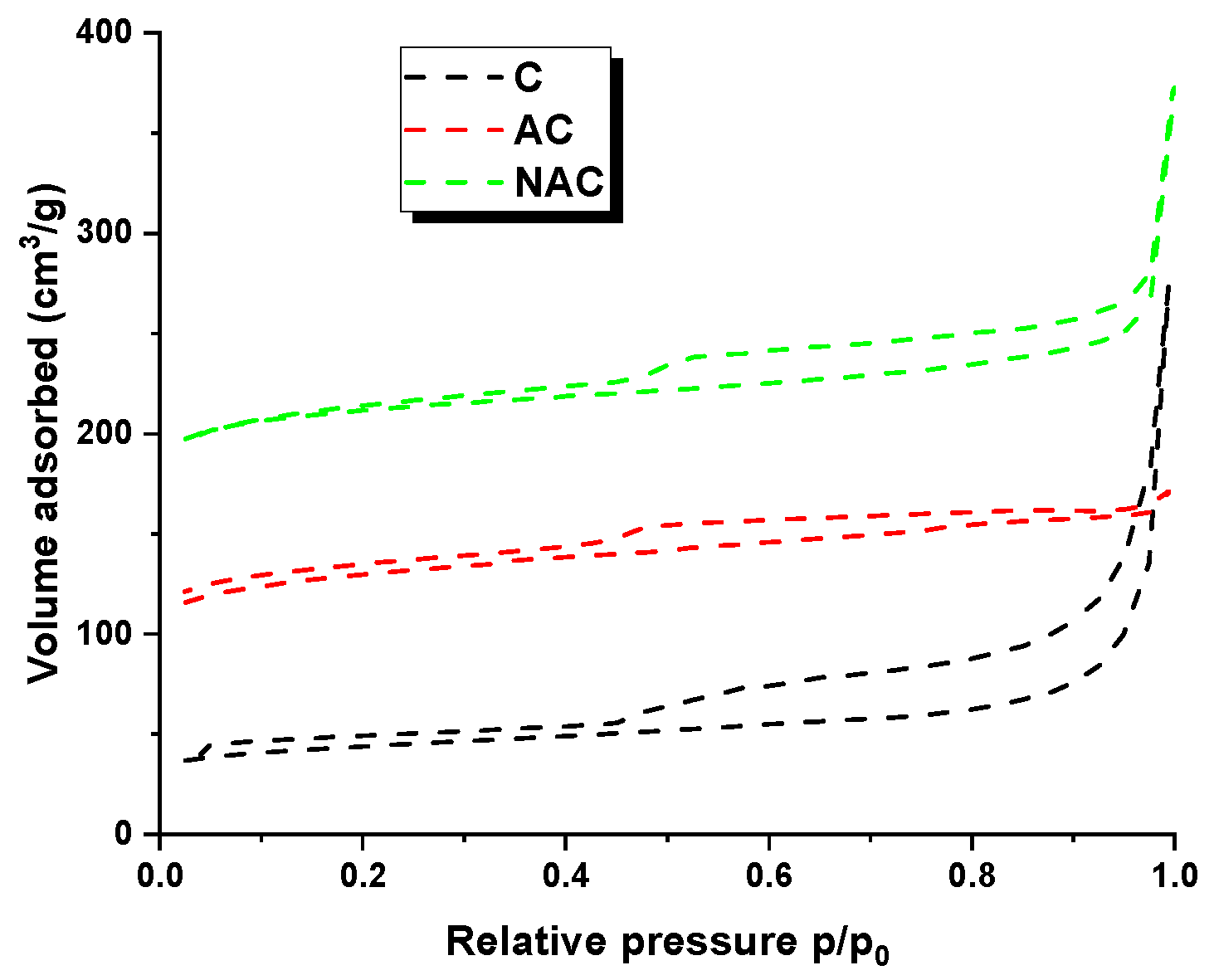

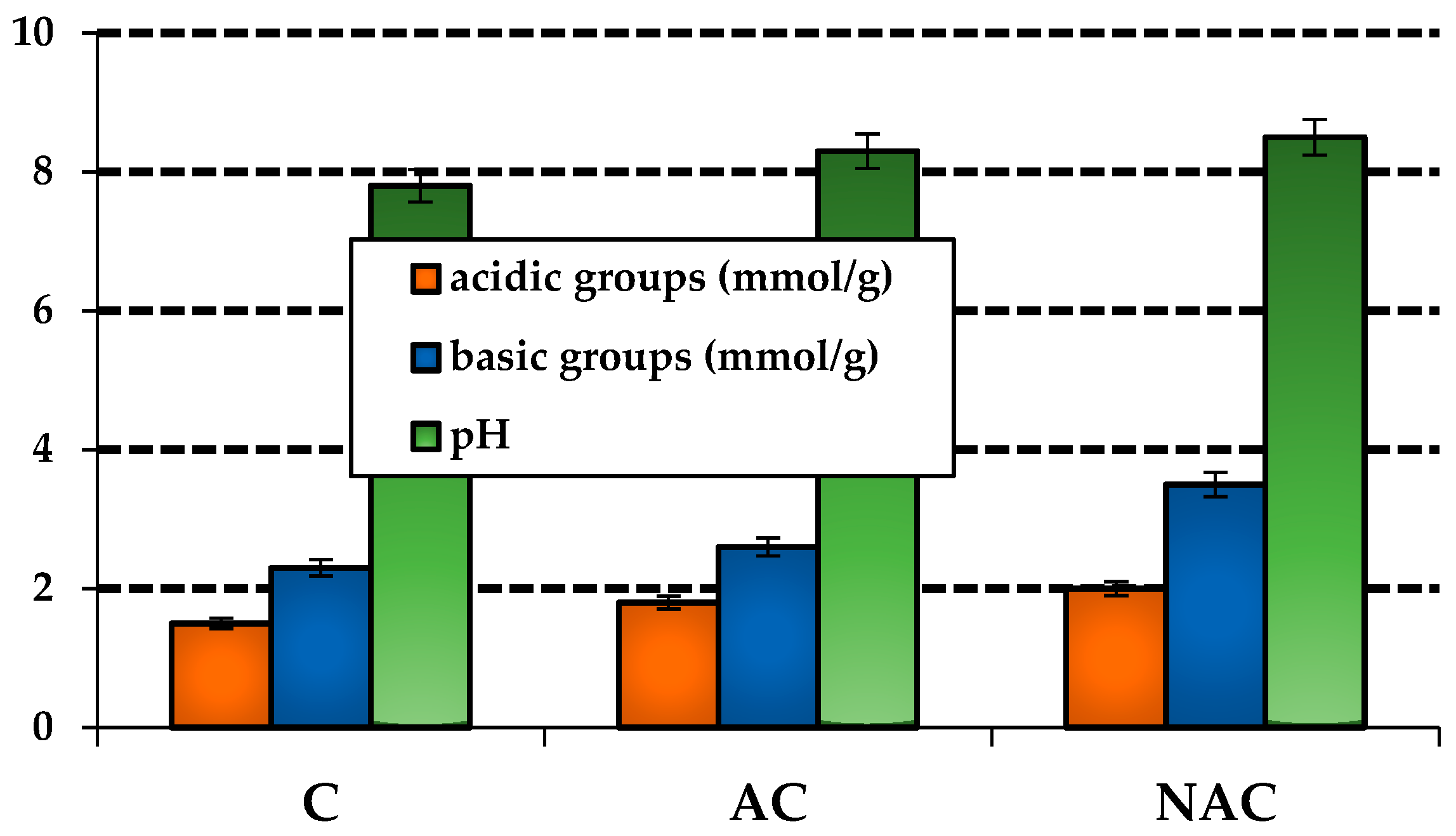
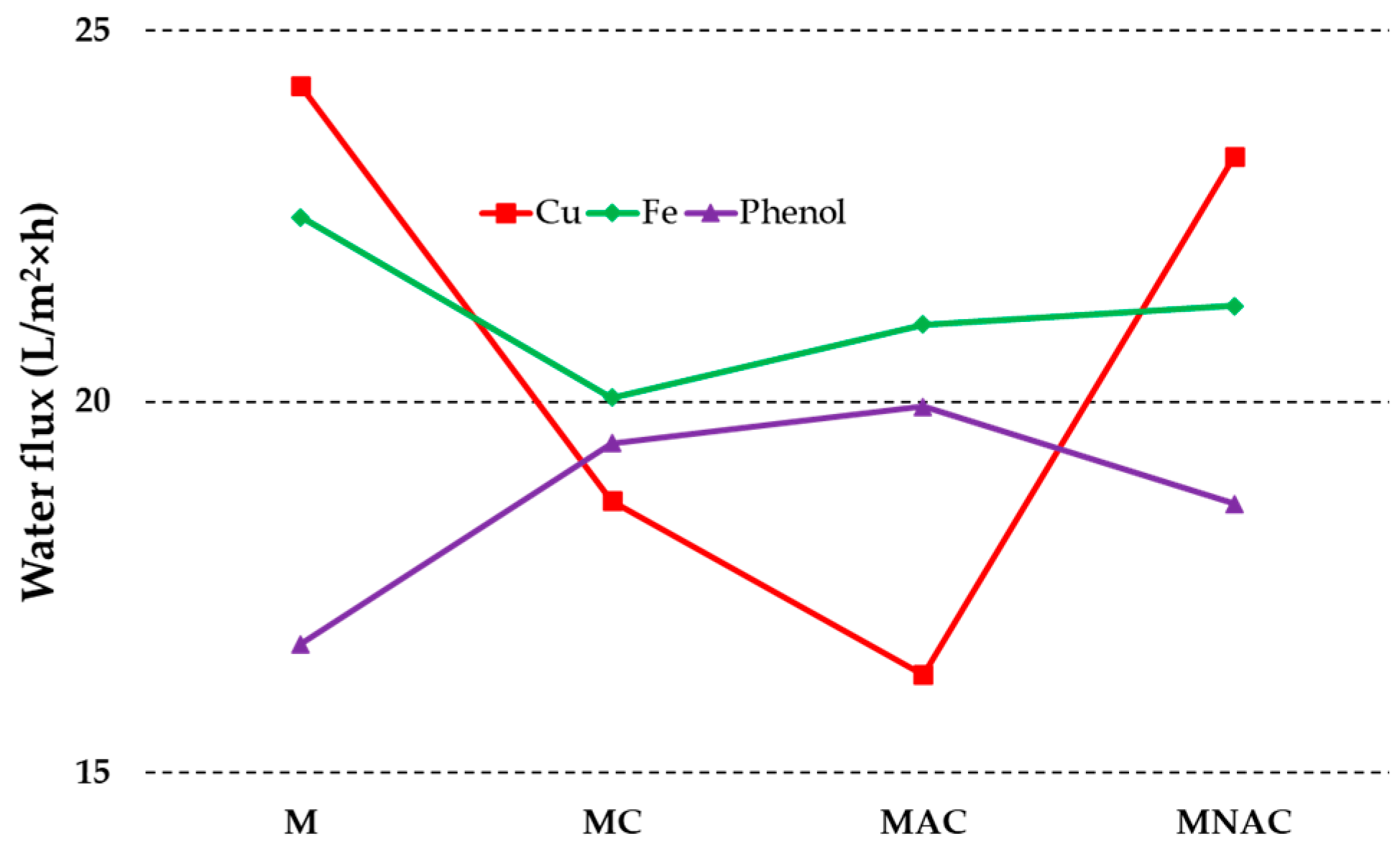
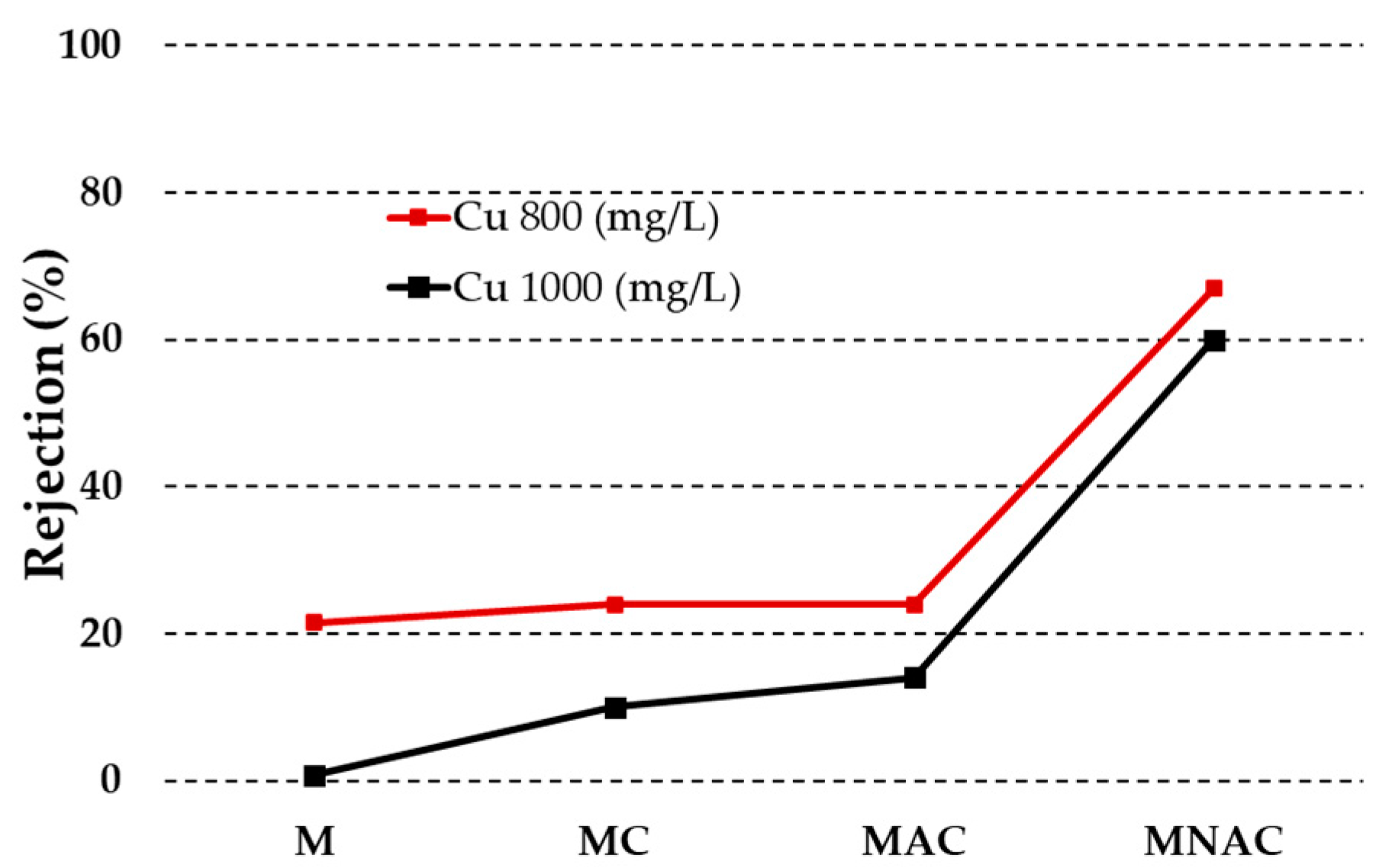
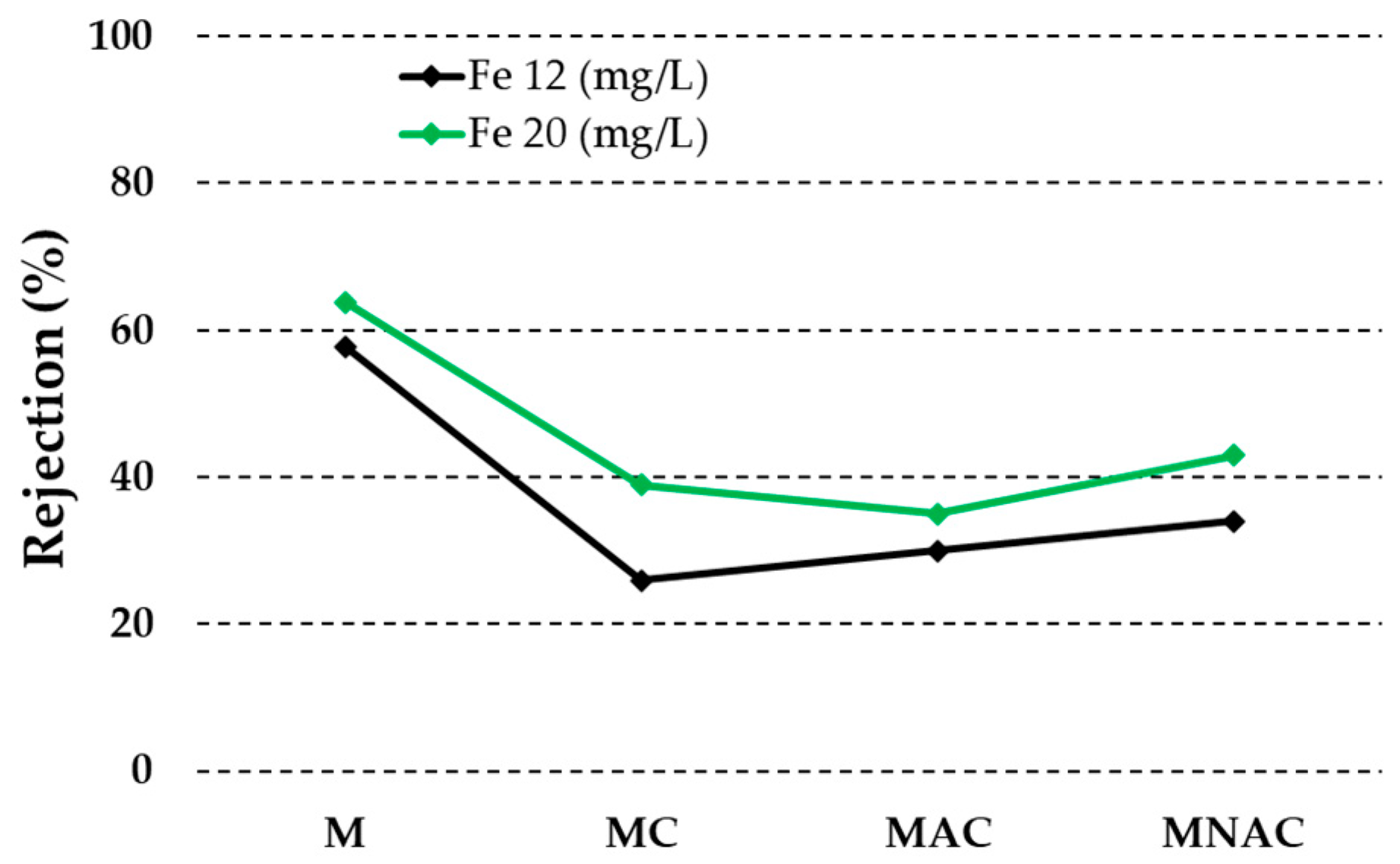
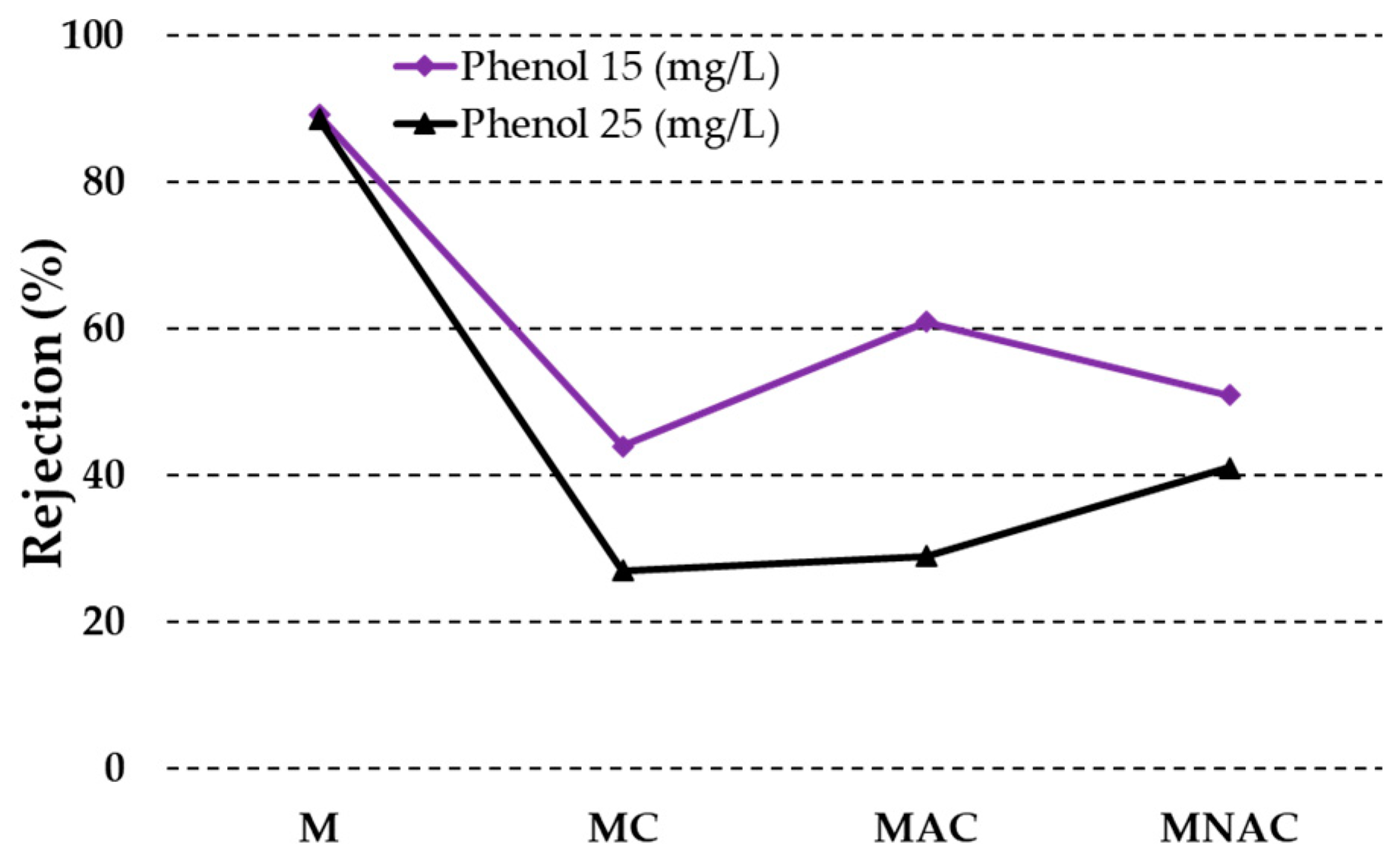
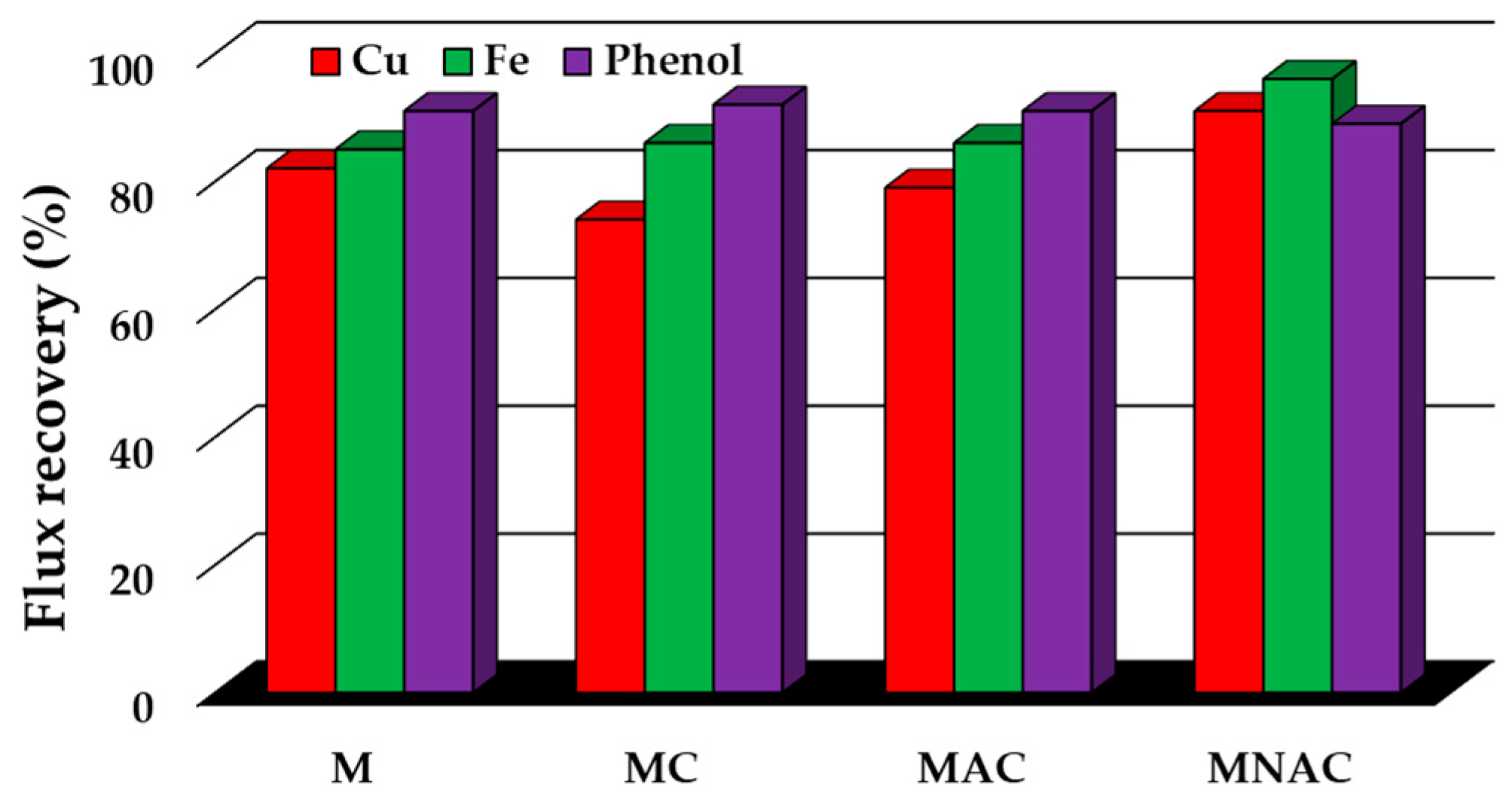
| Carbon Materials | Cdaf | Hdaf | Ndaf | Sdaf | Odaf,1 | Ash |
|---|---|---|---|---|---|---|
| C | 69.2 | 2.1 | 2.9 | 0.2 | 25.7 | 12.1 |
| AC | 74.6 | 2.5 | 3.0 | 0.1 | 19.8 | 14.3 |
| NAC | 86.9 | 2.7 | 4.7 | 0.1 | 5.6 | 7.8 |
| Carbon Materials | Iodine Number (mg/g) | SBET (m2/g) | Total Pore Volume (cm3/g) | Micropore Volume (cm3/g) | Average Pore Diameter (nm) |
|---|---|---|---|---|---|
| C | 205 | 125 | 0.38 | 0.04 | 7.32 |
| AC | 356 | 749 | 0.52 | 0.39 | 4.22 |
| NAC | 644 | 888 | 0.60 | 0.44 | 4.15 |
| Membrane | ε (%) | EWC (%) | Contact Angle ° |
|---|---|---|---|
| M | 50.31 ± 2.61 | 76.74 ± 4.61 | 62.80 ± 1.47 |
| MC | 68.60 ± 3.79 | 88.21 ± 5.28 | 60.08 ± 4.09 |
| MAC | 38.01 ± 1.14 | 80.13 ± 4.17 | 57.12 ± 2.97 |
| MNAC | 62.71 ± 3.19 | 85.62 ± 4.88 | 58.24 ± 3.57 |
| Membrane | Acidic Groups | Basic Groups | Total Content of Oxygen Groups |
|---|---|---|---|
| M | 3.69 ± 0.23 | 1.66 ± 0.11 | 5.35 ± 0.34 |
| MC | 2.57 ± 0.17 | 5.05 ± 0.32 | 7.62 ± 0.37 |
| MAC | 5.19 ± 0.32 | 4.60 ± 0.28 | 9.79 ± 0.45 |
| MNAC | 2.80 ± 0.21 | 5.19 ± 0.32 | 7.99 ± 0.39 |
| Membrane | Rm (×1013) | Rp (×1013) | Rc (×1013) | Rt (×1013) |
|---|---|---|---|---|
| M | 4.65 ± 0.19 | 5.82 ± 0.34 | 5.80 ± 0.31 | 16.27 ± 1.05 |
| MC | 5.79 ± 0.23 | 7.80 ± 0.57 | 9.07 ± 0.88 | 22.66 ± 1.45 |
| MAC | 6.64 ± 0.24 | 8.42 ± 0.68 | 10.20 ± 0.93 | 25.26 ± 2.99 |
| MNAC | 4.65 ± 0.20 | 5.15 ± 0.43 | 4.52 ± 0.42 | 14.32 ± 0.99 |
| Membrane | Rm (×1013) | Rp (×1013) | Rc (×1013) | Rt (×1013) |
|---|---|---|---|---|
| M | 4.87 ± 0.18 | 5.71 ± 0.53 | 5.25 ± 0.52 | 15.83 ± 1.59 |
| MC | 5.49 ± 0.24 | 6.36 ± 0.77 | 6.45 ± 0.65 | 18.30 ± 1.78 |
| MAC | 5.14 ± 0.21 | 5.98 ± 0.49 | 6.38 ± 0.63 | 17.50 ± 1.68 |
| MNAC | 5.09 ± 0.24 | 5.34 ± 0.47 | 5.08 ± 0.49 | 15.51 ± 1.56 |
| Membrane | Rm (×1013) | Rp (×1013) | Rc (×1013) | Rt (×1013) |
|---|---|---|---|---|
| M | 6.59 ± 0.88 | 7.19 ± 0.94 | 6.41 ± 0.82 | 17.19 ± 1.48 |
| MC | 5.58 ± 0.79 | 6.07 ± 0.84 | 5.57 ± 0.57 | 17.22 ± 1.47 |
| MAC | 5.62 ± 0.81 | 6.12 ± 0.83 | 5.95 ± 0.59 | 17.69 ± 1.54 |
| MNAC | 5.80 ± 0.84 | 6.54 ± 0.87 | 6.27 ± 0.63 | 18.61 ± 1.59 |
Disclaimer/Publisher’s Note: The statements, opinions and data contained in all publications are solely those of the individual author(s) and contributor(s) and not of MDPI and/or the editor(s). MDPI and/or the editor(s) disclaim responsibility for any injury to people or property resulting from any ideas, methods, instructions or products referred to in the content. |
© 2024 by the authors. Licensee MDPI, Basel, Switzerland. This article is an open access article distributed under the terms and conditions of the Creative Commons Attribution (CC BY) license (https://creativecommons.org/licenses/by/4.0/).
Share and Cite
Przybyl, J.; Bazan-Wozniak, A.; Poznan, F.; Nosal-Wiercińska, A.; Cielecka-Piontek, J.; Pietrzak, R. Removal of Iron and Copper Ions and Phenol from Liquid Phase by Membrane Based on Carbonaceous Materials. Materials 2024, 17, 2788. https://doi.org/10.3390/ma17122788
Przybyl J, Bazan-Wozniak A, Poznan F, Nosal-Wiercińska A, Cielecka-Piontek J, Pietrzak R. Removal of Iron and Copper Ions and Phenol from Liquid Phase by Membrane Based on Carbonaceous Materials. Materials. 2024; 17(12):2788. https://doi.org/10.3390/ma17122788
Chicago/Turabian StylePrzybyl, Joanna, Aleksandra Bazan-Wozniak, Faustyna Poznan, Agnieszka Nosal-Wiercińska, Judyta Cielecka-Piontek, and Robert Pietrzak. 2024. "Removal of Iron and Copper Ions and Phenol from Liquid Phase by Membrane Based on Carbonaceous Materials" Materials 17, no. 12: 2788. https://doi.org/10.3390/ma17122788
APA StylePrzybyl, J., Bazan-Wozniak, A., Poznan, F., Nosal-Wiercińska, A., Cielecka-Piontek, J., & Pietrzak, R. (2024). Removal of Iron and Copper Ions and Phenol from Liquid Phase by Membrane Based on Carbonaceous Materials. Materials, 17(12), 2788. https://doi.org/10.3390/ma17122788








